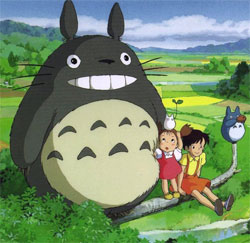The basic requirements for kid-friendly anime are pretty commonsensical:
1. No fan service.
This doesn’t mean that the characters have to be in burkas all the time, but it does require a sense of innocence. For example, in Sugar: Snow Fairy we do routinely see characters in the bath, and in Haibane Renmei we see the girls in various states of undress, but the context of these scenes is so totally inoocent that you’d have to be a real kimura to find any “service” in them. From Steven’s description, it seems that the fan service in World of Narue would not be too objectionable, but I’d have to review some examples of the more egregious examples to get a sense for whether it would be suitable or not.
2. Young characters.
But not too young; ideally the main character should be a few years older minimum than the child who will be watching, and if possible the same gender. The reason is simple – kids emulate older kids, and boss around younger ones. A child won’t relate to characters that are too young, and won’t identify a character that is too old as a peer.
For my daughter, who just turned four, characters in the age range of 5-11 are pretty much ideal. It is worth noting that when she first saw S:SF, she was three and a half, and found the character of Cannon pretty uninteresting. However she absolutely idolized Yume from Someday’s Dreamers.
For little girls especially, the entire genre of mahou shoujo (magical girl) is pretty much a guaranteed hit (as long as it is in compliance with the other guidelines, of course).
and finally, most importantly,
3a. A moral lesson or example of personal growth,
and/or
3b. A sense of wonder.
The first option is self-explanatory – essentially the same driving force (other than merchandising) underlying all children’s programming. Ultimately any time spent in front of television is time that is not spent outdoors, on the internet, at school, or with family. Therefore, that TV time has to maintain a minimum level of educational value. In anime, however, even in the simplest children-oriented anime that I have seen thus far, the characters have a depth that is totally absent in regular child’s fare like PBS Kids or Disney Playhouse – there’s a maturity that isn’t neccessarily adult. The potential to educate a child by example, and role model, is vast – and after parental example it is unfortunately what kids see on television that shapes their values. Even the best of parents need to rely on the TV to help out once in a while; the TV can never replace a parent but it can relieve a parent from time to time.
The second option however is more vague. By sense of wonder, I mean an inspiration for creativity, a culturing of the innate curiosity that children have and which adults often must struggle to rediscover. The classic example in my mind of this is My Neighbor Totoro, which is perhaps the most Ghibli of the Ghibli films. There really isn’t a lot of plot, and the story also seems to end abrupt;y, but the plot isn’t really the point. It’s about the intersection of the real world and the fantasy world, and how children are uniquely positioned at that nexus. Seeing the universe through a child’s eyes is a liberating experience – your own perceptions melt away and you see things again, as if new. And you see new things as well. As far as anime is a form of art, this is the ideal to which it must strive, especially if the target audience is a child.
Recommendations and lists below the fold… (more…)
